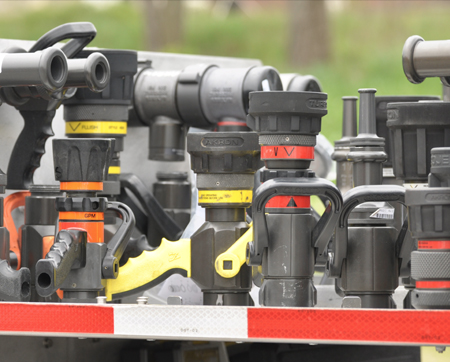
The handline nozzle is an important part of the firefighting system and there are many choices available in today’s market. The selection of the nozzle to be used by the department should depend upon the tactics and performance required. Deciding up front what you want your nozzle to do before making your decision will save you time and ultimately ensure you are satisfied with your nozzles.
This is a two-part white paper with Part 1 focusing on what nozzles do and nozzle types available in today’s market. Part 2 concentrates on some considerations for selecting a nozzle.
Selecting a Nozzle
When selecting a nozzle, it is important to choose the type that is best suited for your applications. The following information will help you determine which configurations are best for you.
1. What flow range is required?
The available water, pump capacity, hose lays, etc., determine what a nozzle can achieve. The system needs to be analyzed to determine what flow range can be achieved. Some considerations should be to:
- Understand the maximum flow rate that can be achieved with normal engine pressures and hose lays.
- Determine the minimum flow that will be required.
- Decide whether the nozzle will always be used on the same hose or whether it will be used in other applications, which might require different flows.
2. How much flow can be controlled by the available manpower?
Reaction force is determined by the gallons per minute of flow (gpm), nozzle pressure at the inlet and pattern. Determine the maximum flow that can be controlled by the available manpower. The more manpower available on the hose line, more flow and pressure can be physically handled for a longer period of time. If human resources are limited, considering nozzles with lower flows and/or reducing the rated pressure may help with firefighter fatigue.
3. Are different patterns required?
Decide whether a smooth bore nozzle or fog/straight stream nozzle is required. Smooth bore nozzles typically provide the greatest amount of reach at lower pressure. Quality fog nozzles produce almost as good a straight stream as a solid bore nozzle but in some cases do require a higher nozzle inlet pressure and provide the flexibility of narrow and wide fog streams.
If the lower pressure performance of a smooth bore nozzle combined with the patterns of a fog/straight stream nozzle would accommodate your needs best, consider a multi-purpose or break-apart fog nozzle with the compact solid bore and fog tip.
Fog nozzles are designed to provide a dispersed stream to protect personnel and hydraulically ventilate. Spinning teeth are provided to break up the water into smaller droplets providing excellent breakup of water for heat absorption and steam conversion, due to the elimination of fingering, which is especially important in liquefied petroleum gas (LPG) type fires.
4. Who should control the flow – the nozzle operator or the pump operator?
Determine whether it is necessary to change the flow rate while operating. If so, decide whether the nozzle operator or the pump operator should control the flow rate.
- If the nozzle operator should control the flow rate, an adjustable gallonage nozzle could be the best choice.
- If the pump operator is to control the flow rate, a single gallonage (fixed, or variable pressure/variable flow), an automatic nozzle or a multi-purpose nozzle would probably be the best.
5. How durable should the nozzle be and what is the warranty?
Nozzles are designed to withstand reasonably tough service, but some nozzles will withstand more abuse than others. If durability is crucial and maintenance and repair opportunities are limited, a less complex nozzle design might be the best choice. Warranty is an important consideration. Some nozzles are warranted for 10 years, others 5 years and some less.
6. What is the level of training?
Departments provide various amounts of training for the pump operator and the nozzle operator. The nozzle should complement the training.
Smooth bore nozzles require the least amount of training for the pump operator and the nozzle operator. The engine pressure depends mainly on the length and size of hose.
Fixed orifice nozzles require somewhat more training than the smooth bore nozzle. The training would include when to use your various spray patterns characterized by a fog nozzle.
Selectable gallonage fog nozzles require additional training of the pump operator and the nozzle operator because of changes to the pump operating pressure that will be required for each of the flow settings.
Break-apart nozzles require training that includes potential use of the shutoff as a hose line extender and under what circumstances is the nozzle person required to use the smooth bore tip and the fog nozzle. The pump operator and the nozzle operator must be trained to communicate nozzle tip changes so that pressure can be adjusted at the pump as needed.
Automatic/constant pressure fog nozzles also require additional training of the pump operator and the nozzle operator. The pump operator must be trained to accurately control the engine pressure and flow with different lengths and sizes of hoses and under different operating conditions.
Multi-purpose nozzles require additional training for the nozzle operator, because they must be trained to use the different spray patterns and versed in the operation of the nozzle if it has multiple shutoffs.
Requesting a distributor do a demonstration is a great way to experience the variety of available nozzle options in action. After analyzing your needs and considering the strengths and purposes of each nozzle, you will be better prepared to choose how to spend your limited resources on the right combination of nozzles for your department.

